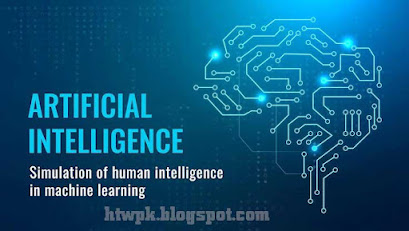Artificial intelligence | AI artificial intelligence
In simple
terms, artificial intelligence (AI) refers to systems or machines that mimic human
intelligence to perform tasks and can iteratively improve based on the
information they collect. AI manifests itself in various ways. Some examples
are:
Chatbots use
AI artificial intelligence to
understand customer issues faster and provide more efficient responses
Intelligent assistants use AI artificial inteligence to analyze critical information from large free-text data sets to improve programming Recommendation engines can provide automated recommendations for TV shows based on users' viewing habits.
Definition of artificial intelligence.
Artificial intelligence is the ability of a machine to present the same capacities as human beings, such as reasoning, learning, creativity and the ability to plan.
AI artificial intelligence allows technological systems to perceive their environment, relate to it, solve problems and act with a specific purpose. The machine receives data (already prepared or collected through its own sensors, for example a camera), processes it and responds to it.
AI artificial intelligence systems are able to adapt their behavior to some extent, analyze the effects of previous actions, and work autonomously.
What are the advantages and disadvantages of artificial intelligence?
Advantages
- Good at detail-oriented jobs;
- Reduced time for data-heavy tasks;
- Delivers consistent results; and
- AI-powered virtual agents are always available.
Disadvantages
- Expensive;
- Requires deep technical expertise;
- Limited supply of qualified workers to build AI tools;
- Only knows what it's been shown; and
- Lack of ability to generalize from one task to another.
What are the 4 types of artificial intelligence?
AI can be
categorized into four types, beginning with the task-specific intelligent
systems in wide use today and progressing to sentient systems, which do not yet
exist. The categories are as follows:
1: Reactive machines.
These AI systems have no memory and are task
specific. An example is Deep Blue, the IBM chess program that beat Garry Kasparov in
the 1990s. Deep Blue can identify pieces on the chessboard and make
predictions, but because it has no memory, it cannot use past experiences to
inform future ones.
2: Limited memory.
These AI systems have memory, so they can use past
experiences to inform future decisions. Some of the decision-making functions
in self-driving cars are designed this way.
3: Theory of mind.
Theory of mind is a psychology term. When applied to AI,
it means that the system would have the social intelligence to understand
emotions. This type of AI will be able to infer human intentions and predict
behavior, a necessary skill for AI systems to become integral members of human
teams.
4: Self-awareness.
In this category, AI systems have
a sense of self, which gives them consciousness. Machines with self-awareness
understand their own current state. This type of AI does not yet exist.
History of AI Artificial intelligence?
The concept of inanimate objects endowed with intelligence has
been around since ancient times. The Greek god Hephaestus was depicted in myths
as forging robot-like servants out of gold. Engineers in ancient Egypt built
statues of gods animated by priests. Throughout the centuries, thinkers from
Aristotle to the 13th century Spanish theologian Ramon Llull to René Descartes
and Thomas Bayes used
the tools and logic of their times to describe human thought processes as
symbols, laying the foundation for AI concepts such as general knowledge
representation.
1950s.
With the advent of
modern computers, scientists could test their ideas about machine intelligence.
One method for determining whether a computer has intelligence was devised by
the British mathematician and World War II code-breaker Alan Turing. The Turing
Test focused on a computer's ability to fool interrogators into believing its
responses to their questions were made by a human being.
1956.
The modern field
of artificial intelligence is widely cited as starting this year during a
summer conference at Dartmouth College. Sponsored by the Defense Advanced
Research Projects Agency (DARPA), the conference was attended by 10 luminaries
in the field, including AI pioneers Marvin Minsky, Oliver Selfridge and John McCarthy, who is credited with coining
the term artificial intelligence. Also in attendance were Allen
Newell, a computer scientist, and Herbert A. Simon, an economist, political
scientist and cognitive psychologist, who presented their groundbreaking Logic
Theorist, a computer program capable of proving certain mathematical theorems
and referred to as the first AI program.
1950s and 1960s.
In the wake of the
Dartmouth College conference, leaders in the fledgling field of AI predicted
that a man-made intelligence equivalent to the human brain was around the
corner, attracting major government and industry support. Indeed, nearly 20
years of well-funded basic research generated significant advances in AI: For
example, in the late 1950s, Newell and Simon published the General Problem
Solver (GPS) algorithm, which fell short of solving complex problems but laid
the foundations for developing more sophisticated cognitive architectures;
McCarthy developed Lisp, a language for AI programming that is
still used today. In the mid-1960s MIT Professor Joseph Weizenbaum developed
ELIZA, an early natural language processing program that laid the foundation
for today's chatbots.
1970s and 1980s.
But the achievement of
artificial general intelligence proved elusive, not imminent, hampered by
limitations in computer processing and memory and by the complexity of the
problem. Government and corporations backed away from their support of AI
research, leading to a fallow period lasting from 1974 to 1980 and known as the
first "AI Winter." In the 1980s, research on deep learning techniques
and industry's adoption of Edward Feigenbaum's expert systems sparked a new
wave of AI enthusiasm, only to be followed by another collapse of government
funding and industry support. The second AI winter lasted until the mid-1990s.
1990s through today.
Increases in computational
power and an explosion of data sparked an AI renaissance in the late 1990s that
has continued to present times. The latest focus on AI has given rise to
breakthroughs in natural language processing, computer vision, robotics,
machine learning, deep learning and more. Moreover, AI is becoming ever more
tangible, powering cars, diagnosing disease and cementing its role in popular
culture. In 1997, IBM's Deep Blue defeated Russian chess grandmaster Garry
Kasparov, becoming the first computer program to beat a world chess champion.
Fourteen years later, IBM's Watson captivated the public when
it defeated two former champions on the game show Jeopardy!. More recently, the
historic defeat of 18-time World Go champion Lee Sedol by Google DeepMind's
AlphaGo stunned the Go community and marked a major milestone in the
development of intelligent machines.
Why is AI artificial intelligence important?
Some smart
technologies have been around for more than 50 years, but advances in computing
power, the availability of huge amounts of data, and new algorithms have
enabled huge AI advances in recent years.
Artificial
intelligence has a central role in the digital transformation of society and
has become an EU priority.
Its future
applications are expected to bring about big changes, but AI is already present
in our lives.
Find out more
about the opportunities and challenges of artificial intelligence and how
Parliament wants to regulate it.
AI artificial inteligence is much more about the process and ability of superpowered thinking and data analysis than it is about any particular format or function. Although AI shows images of high-functioning human-like robots taking over the world, AI artificial inteligence is not intended to replace humans. Its goal is to significantly enhance human capabilities and contributions. That makes it a very valuable business asset.
Uses of AI artificial inteligence in our daily life.
Software: virtual assistants, image analysis software, search engines, voice and face recognition systems Integrated artificial intelligence: robots, drones, autonomous vehicles, Internet of Things
Artificial
intelligence in everyday life.
Below are some AI
apps you may not have known used this ability.
Internet
shopping and advertising.
Artificial
intelligence is widely used to create personalized recommendations for consumers,
based on, for example, their previous searches and purchases or other online
behavior. AI is very important in commerce, to optimize products, plan
inventory, logistics processes, etc.
Web
searches.
Search engines
learn from the vast amount of data that their users provide to deliver relevant
search results.
Personal
digital assistants.
Smartphone mobile
phones use AI for a product that is as relevant and personalized as possible.
The use of virtual assistants that answer questions, give recommendations and
help organize their owners' routines has become widespread.
Automatic
translations.
Language
translation software, either based on written or spoken text, relies on
artificial intelligence to provide and improve translations. This also applies
to functions such as automated subtitling.
Smart
houses, cities and infrastructure.
Smart thermostats
learn from our behavior to save energy, while smart city developers hope to
regulate traffic to improve connectivity and reduce congestion.
Vehicles.
Although self-driving
vehicles are not yet widespread, cars already use AI-powered safety features.
For example, the EU helped finance the vision-based driver assistance system
VI-DAS, which detects potentially dangerous situations and accidents.
Navigation is heavily
based on AI.
Artificial intelligence IN Cybersecurity.
Artificial
intelligence systems can help recognize and fight cyber-attacks and other
online threats based on the data they continuously receive, recognizing
patterns and preventing attacks.
Artificial
intelligence to fight against Covid-19.
AI has been used
in thermal imaging cameras installed at airports and elsewhere. In medicine, it
can help recognize an infection of the lungs from a test called a CT scan. It
has also been used to provide data to track the spread of the disease.
Fight
against disinformation.
Some applications
of artificial intelligence can detect fake news and disinformation by
extracting information from social networks, looking for sensational or
alarming words, and identifying which online sources are considered
authoritative.
Find out more
about how MEPs want to regulate data legislation to promote innovation and
ensure security.
Other
examples of AI applications.
AI artificial intelligence is intended to transform almost every aspect of life and the economy. These are other examples:
Artificial intelligence in Health.
Researchers are studying
how to use AI to analyze vast amounts of health data to find patterns that
could lead to new discoveries in medicine and other ways to improve individual
diagnoses.
For example,
researchers developed an AI program that responded to emergency calls and said
it detected cardiac arrest faster than a doctor could.
Separately, EU
co-funded KConnect is developing multilingual text and search services that
help people find the most relevant medical information available
Artificial intelligence in Transport.
Artificial
intelligence could improve the safety, speed and efficiency of rail traffic by
minimizing wheel friction, maximizing speed and enabling autonomous driving.
Artificial intelligence in manufactures.
Artificial
intelligence can help make European producers more efficient and empower
factories in Europe again by using robots, optimizing sales journeys, or with
timely predictions of needed maintenance or breakdowns in "smart
factories."
The EU co-funded
research project SatisFactory uses collaborative augmented reality systems to
increase job satisfaction in "smart factories".
Artificial intelligence in food and
agriculture.
AI can be used to
build a sustainable food system: it could ensure healthier food by minimizing
the use of fertilizers, pesticides and irrigation; improve productivity and
reduce environmental impact. In addition, the robots could remove weeds and
reduce the use of herbicides.
In the EU, many
farmers are already using AI to monitor the movement, temperature and feed
consumption of their herds.
Artificial intelligence in Public
administration and services.
By using vast
amounts of data and recognizing patterns, AI could anticipate natural
disasters, enable proper preparation, and reduce their consequences.
What is Artificial intelligence terminology.
AI artificial intelligence has become an umbrella term for applications that perform complex tasks that previously required human input, such as communicating with customers online or playing chess. The term is often used interchangeably with its subfields, which include machine learning and deep learning. However, there are certain differences. For example, machine learning focuses on creating systems that learn or improve their performance based on the data they consume. It is important to note that while all machine learning is AI, artificial intelligence not all AI artificial intelligence is machine learning.
To get the full
value of AI, artificial intelligence many companies are making significant
investments in data science teams. An interdisciplinary field that uses
scientific and other methods to extract value from data, data science combines
skills from fields such as statistics and computer science with business
knowledge to analyze data collected from multiple sources.
How AI artificial
inteligence can help organizations.
The fundamental
principle of AI is to replicate, and then exceed, the way humans perceive and
react to the world. It is fast becoming the cornerstone of innovation. AI,
powered by various forms of machine learning that recognize patterns in data to
enable predictions, can add value to your business by:
Provide a more
complete understanding of the wealth of data available
Relying on
predictions to automate overly complex or mundane tasks.
AI artificial
inteligence in the companies.
Currently, AI
technology improves the performance and productivity of the company by
automating processes or tasks that previously required human effort. AI can
also make sense of data on a scale no human ever could. This capability can
lead to significant business benefits. For example, Netflix uses machine
learning to provide a level of personalization that helped the company grow its
customer base by more than 25% in 2017.
Most companies
have made data science a priority and are investing heavily in it. In Gartner's
latest survey of more than 3,000 CIOs and CIOs, respondents ranked analytics
and business intelligence as the most important differentiating technologies
for their organizations. CTOs and CIOs surveyed consider these technologies to
be the most strategic for their companies and therefore are attracting new
investment.
AI has value to
almost every function, business, and industry. Includes general and
industry-specific applications such as:
Using
transactional and demographic data to predict how much certain customers will
spend over the course of their relationship with a business (or customer
lifetime value)
Price
optimization based on customer behavior and preferences
Using image
recognition to analyze X-ray images for cancer symptoms.
How
companies use AI.
According to the
Harvard Business Review, companies use AI primarily to:
Detect and deter
security intrusions (44%)
Solve user
technology problems (41%)
Reduce the work
of production management (34%)
Measure internal
compliance in the use of approved vendors (34%)
What is
driving AI artificial intelligence adoption?
Three factors
that are driving the development of AI across industries:
Affordable,
high-performance computing power is now available. The abundance of commodity
computing power in the cloud allows easy access to affordable, high-performance
computing power. Prior to this development, the only computing environments
available for AI were non-cloud based and cost prohibitive.
Large volumes of
data are available for training. AI must be trained on a lot of data to make
the right predictions. The emergence of different tools for labeling data,
along with the ease and affordability with which organizations can store and
process structured and unstructured data, enables more organizations to design
and train AI algorithms.
Applied AI provides
a competitive advantage. Increasingly, companies are recognizing the
competitive advantage of applying AI insights to business goals and are making
it a company-wide priority. For example, the specific recommendations provided
by AI can help companies make better decisions faster. Many of the features and
capabilities of AI can reduce costs and risks, speed time to market, and much
more.
The
benefits and challenges of putting AI into practice.
There are
numerous success stories that demonstrate the value of AI. Organizations that
embed machine learning and cognitive interactions into traditional business
processes and applications further improve user experience and productivity.
However, the
foundation is not strong enough. Few companies have implemented AI in a
balanced way for various reasons. For example, if they don't use cloud
computing, AI projects are often computationally expensive. They are also
complex to design and require expertise that is in high demand but in short
supply. Knowing when and where to incorporate AI, as well as when to turn to a
third party, will help minimize these pitfalls.
AI artificial
intelligence success stories
AI is the driving
factor behind some significant success stories:
According to the
Harvard Business Review, the Associated Press produced 12 times more stories by
training AI software to automatically write low-profit news stories. This
effort freed up their journalists to write more detailed accounts.
Deep Patient, an
AI-powered tool designed by the Icahn School of Medicine at Mount Sinai,
enables clinicians to identify high-risk patients even before illnesses are
diagnosed. The tool analyzes a patient's medical history to predict nearly 80
diseases up to a year before onset, according to insideBIGDATA.
artificial
inteligence
ai artificial
inteligence
artificial
general inteligence







0 Comments
don't spam comments, please ...